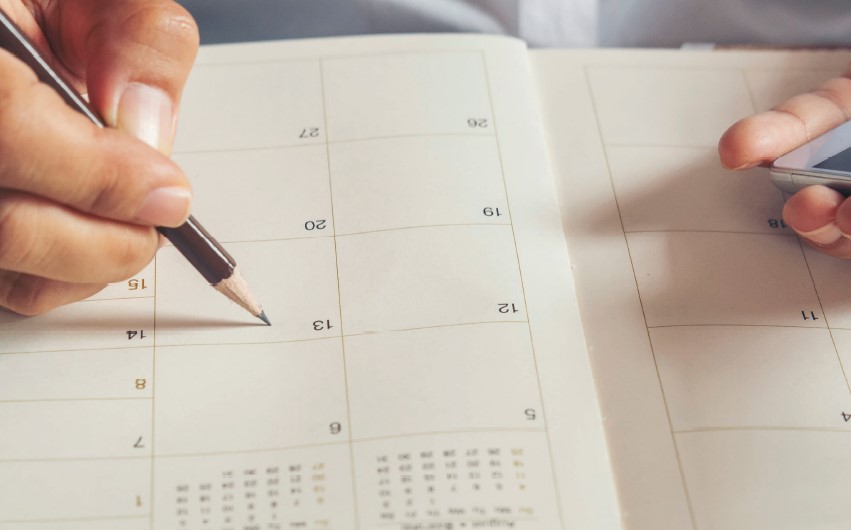Making The Move
Making the decision that you want to move to a senior living community is a big step toward a more worry-free future. But what’s the next step? And the one after that? This guide will help you plan your move and show you each step you need to take along the way.

First Things First
If you haven’t already decided which community you’d like to move to, start by contacting the senior living communities you want to find out about. Request information about each one.
Then attend at least one virtual or in-person event at those communities so you can get a better sense of what it’s like there. Scheduling a virtual or in-person personal appointment is also critical to making a decision.
Getting Organized
Create a moving binder to help you stay organized during the process. It will help you keep information in one central place so you’ll always know where to find it. Use tabbed dividers to keep different kinds of information separate and consider adding dividers with pockets to hold smaller things like receipts or business cards.
Your binder can include:
- A calendar of key dates and move milestones
- Task lists
- Contact information
- Estimates and bids
- Receipts
- Floor plan and customization choices for your new residence
- Change of address checklist
- Inventory of what you’re taking with you
Your Moving Timeline
While every community has its own process, this will give you an idea of what a typical timeline looks like for moving into independent living.
12 10 9
Months before making move
- Find a real estate agent.
- Schedule a house appraisal.
- List and schedule home repairs and/or upgrades needed
- to put your house on the market.
- Consult with your fi nancial planner.
- Narrow your community search to your top two picks.
9 8 7
Months before making move
- Choose the senior living community you want to move to.
- Start downsizing and decluttering.
- Make at least one new acquaintance among the residents of the community. Sales counselors are always happy to introduce you to residents.
- Schedule an appointment to select a floor plan (virtually or in person).
- Schedule an appointment with the community’s downsizing expert (virtually or in person).
- If you haven’t already, talk to your children and other close family members about what’s happening.
6 5 4
Months before making move
- Complete home repairs/upgrades.
- Make deposit on your residence.
- Finish downsizing.
- Choose floor plan.
- Consult real estate agent about when to list your house.
- Make appointment with move-in coordinator.
4 3
Months before making move
- Get moving estimates.
- Create a calendar for the important moving dates –including packing, transition, move-in.
- Contact insurance providers about the change of address – and adjust policies, as needed.
2
Months before making move
- Schedule utility disconnects and make change of address notifications.
- Get markers and labels so you’ll be ready to label boxes.
- Schedule your post-move-out cleaning services, if needed.
- Gather valuables and important documents such as jewelry, checkbooks, legal documents, insurance policies, financial documents, medical records and other important files, and keep them in a lockable box you’ll personally transport to your new home.
- Confirm moving details.
- Start cleaning out the pantry and deep freeze.
- Remember to also reduce cleaning supplies.
- Schedule post-move cleaning services.
- If you’re moving out of state, request copies of personal medical records (and vet records) and get any necessary medication.
Final Week
- Pack suitcase for your first week after the move.
- Include medications.
- Confirm mover arrival.
- Arrange for refreshments for the movers.
- Arrange your own transportation, as needed.
- Ask a neighbor to collect mail that might come after your move.
- If a pet is making the move with you, be sure to pack food and meds to ensure they’ll also have a smooth journey and safe arrival.
- Pack valuables and seldom-used belongings that you’ve chosen to pack yourself.
Moving Day
- Have mover payment ready. Plan to tip the movers.
- 10-20% is good, or for a big move, consider tipping each mover $100.
- Settle your pet somewhere else for the day.
- Let your move-in coordinator supervise, so you can relax.
The Paper Trail
In all the hustle and bustle of moving, it can be easy to lose
track of important documents.
- Put important information in a safe deposit box or fire-proof safe.
- Scan vital documents and store them on your hard drive or online.
- Tell your loved ones where they can find – and how they can access – all these vital documents.
Change of Address Checklist
To help you cover all the bases when it comes to change of address notifications, here’s a helpful list:
Financial Institutions
Banks
Investment broker
Insurance companies
Lenders
Credit reporting systems
Government
Department of Revenue
Internal Revenue Service (IRS)
Department of Motor Vehicles
Business license office (for small or home businesses)
U.S. Post Office
Memberships Service Providers
Professional associations
Publications, subscriptions
Civic organizations
House of worship
Health or fitness club
Social or country clubs
Service Providers
Accountant
Attorney
Cleaning service
Lawn care/landscaper
Physicians
Veterinarian
Hopefully, this guide will help you successfully plan your move
